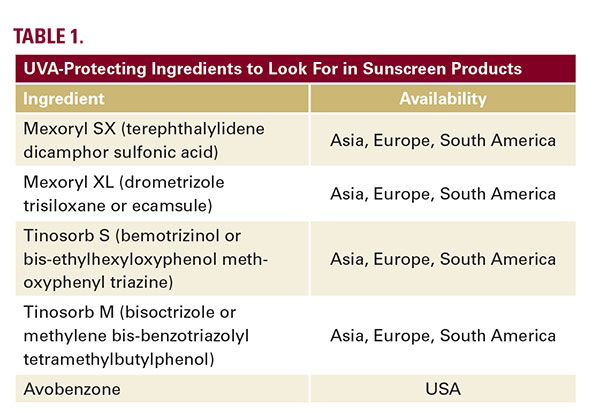

oxygen species (ROS) created by UV rays. Vitamin C, vitamin E, silymarin, and green tea polyphenols have all been utilized in sun protective products,3,19 as have botanical extracts which function as anti-inflammatories in sunscreen products such as licorice, aloe, and chamomile.14 While some of these antiinflammatories may decrease skin redness by targeting ROS, they have no impact on the amount of UV radiation hitting the skin, and we should make patients aware of this.
CONCLUSIONS
In conclusion, American sunscreens remain effective at
minimizing sunburn but are more limited in their protection
against UVA mediated skin disorders such as photoaging and
non-melanoma skin cancers compared to certain international
products. Fortunately, mineral blockers which protect against
both UVA and UVB are becoming more widely used as
formulations have been improved. The time has come in this
complex, confusing, and competitive sunscreen market for
dermatologists to take the lead in providing a framework by
which our patients can make informed choices. We provide this
summary as an aid to ensure that we provide our patients with
clear, concise, and helpful information regarding sun protection.
DISCLOSURES
The authors have no conflict of interest.
REFERENCES
1. Wang SQ, Setlow R, Berwick M, et al. Ultraviolet A and melanoma: a review.
J Am Acad Dermatol. 2001;44(5):837-846.
2. Kullavanijaya P, Lim HW. Photoprotection. J Am Acad Dermatol. 2005;52(6):
937-958; quiz 959-962.
3. Bens G. Sunscreens. Advances in experimental medicine and biology.
2014;810:429-463.
4. Lee JH, Roh MR, Lee KH. Effects of infrared radiation on skin photo-aging
and pigmentation. Yonsei medical journal. 2006;47(4):485-490.
5. Jagdeo J, Austin E, Mamalis A, Wong C, Ho D, Siegel DM. Light-emitting
diodes in dermatology: A systematic review of randomized controlled trials.
Lasers in surgery and medicine. 2018;50(6):613-628.
6. Diffey BL, Osterwalder U, Herzog B. Suntanning with sunscreens: a
comparison with sunbed tanning. Photodermatology, photoimmunology &
photomedicine. 2015;31(6):307-314.
7. FDA Proposes Sunscreen Regulation Changes [press release]. 2019.
8. EWG’s 2019 Guide to Sunscreens. 2019; https://www.ewg.org/sunscreen/
report/executive-summary/. Accessed 4.17.2020.
9. Yeager DG, Lim HW. What's New in Photoprotection: A Review of New
Concepts and Controversies. DermatologicClinics. 2019;37(2):149-157.
10. Matta MK, Zusterzeel R, Pilli NR, et al. Effect of Sunscreen Application Under
Maximal Use Conditions on Plasma Concentration of Sunscreen Active
Ingredients: A Randomized Clinical Trial. JAMA. 2019;321(21):2082-2091.
11. Downs CA, Kramarsky-Winter E, Segal R, et al. Toxicopathological Effects of
the Sunscreen UV Filter, Oxybenzone (Benzophenone-3), on Coral Planulae
and Cultured Primary Cells and Its Environmental Contamination in Hawaii
and the U.S. Virgin Islands. Archives of environmental contamination and
toxicology. 2016;70(2):265-288.
12. Many Common Sunscreens May Harm Coral. Here's What To Use Instead.
2018; https://www.npr.org/sections/health-shots/2018/07/02/624379378/
many-common-sunscreens-may-harm-coral-heres-what-to-use-instead.
Accessed 4.17.2020.
13. Rai R, Shanmuga SC, Srinivas C. Update on photoprotection. Indian journal
of dermatology. 2012;57(5):335-342.
14. Couteau C, Chauvet C, Paparis E, Coiffard LJ. Influence of certain ingredients
on the SPF determined in vivo. Archives of dermatological research.
2012;304(10):817-821.
15. Diffey B. New Sunscreens and the Precautionary Principle. JAMA
dermatology. 2016;152(5):511-512.
16. Imperfect Protection: EWG’s analysis of UV protection offered by US
sunscreens. 2016; https://www.ewg.org/sunscreen/report/imperfectprotection/.
Accessed 5/4, 2020.
17. Wang SQ, Xu H, Stanfield JW, Osterwalder U, Herzog B. Comparison of
ultraviolet A light protection standards in the United States and European
Union through in vitro measurements of commercially available sunscreens.
Journal of the American Academy of Dermatology. 2017;77(1):42-47.
18. Schneider SL, Lim HW. A review of inorganic UV filters zinc oxide and
titanium dioxide. Photodermatology, photoimmunology & photomedicine.
2019;35(6):442-446.
19. Couteau C, Cheignon C, Paparis E, Coiffard LJ. Silymarin, a molecule
of interest for topical photoprotection. Natural product research.
2012;26(23):2211-2214.
AUTHOR CORRESPONDENCE
Ellen Gendler MD ellengendlermd@gmail.com






